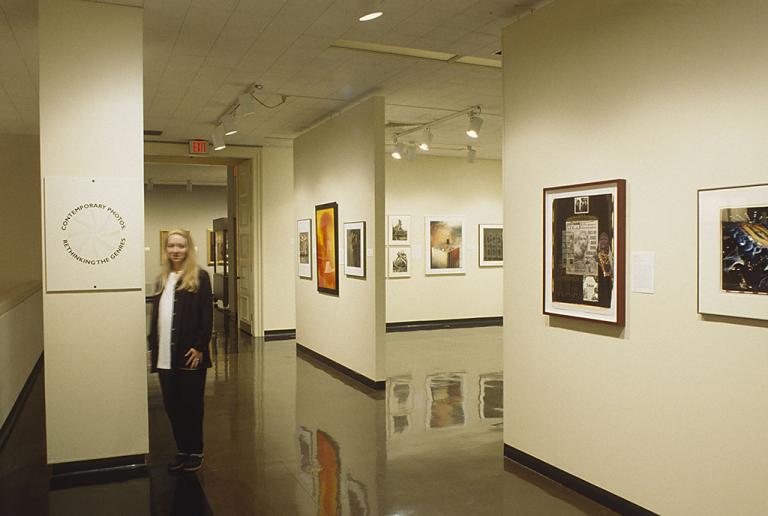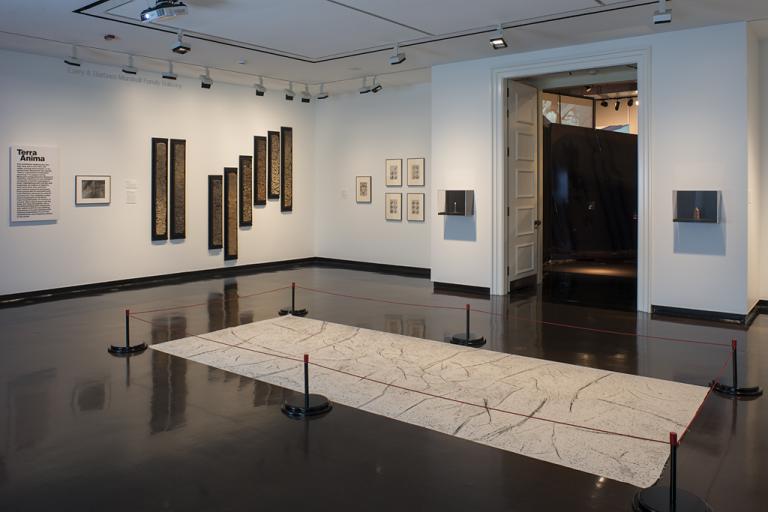Untitled: Silueta Series, Ana Mendieta
Artwork Overview
Image Dimensions Height/Width (Height x Width): 278 x 355 mm
Image Dimensions Height/Width (Height x Width): 10 15/16 x 14 in
Mat Dimensions (Height x Width): 16 x 20 in
If you wish to reproduce this image, please submit an image request
Images
Label texts
This is a photograph of an “earth-body” sculpture made by artist Ana Mendieta to leave her mark on the land in a way that will fade away over time by erosion. Mendieta created the silhouette, or outline of her body, by building up soil and sand in a streambed. She photographed the sculpture to share her art with people who couldn’t be there with her.
What do you think happened to her sculpture over time?
Have you ever built a sandcastle or other sculpture in nature? What do you think happened to it?
“The immigrant artist shares with all other artists the desire to interpret and possibly remake his or her own world.” (p. 18)
“In Haiti the…expression lòt bò dlo, the other side of the water, can be used to denote the eternal afterlife as well as an émigré’s eventual destination.” (p. 94)
As part of her Silueta, or Silhouette, series, Ana Mendieta photo-documented the ephemeral remains of a private sculptural performance, marking the impression of her body by molding soil and sand in a stream bed. An exile from Cuba, Mendieta created this work in multiple locations, forging ties with her Cuban heritage by integrating Santeria, a mix of the religions of Africa and the Americas that was widespread in Cuba, with emerging notions of earthworks, performance, and body art.
As part of her Silueta, or Silhouette, series, Ana Mendieta photo-documented the ephemeral remains of a private sculptural performance, marking the impression of her body by molding soil and sand in a stream bed. An exile from Cuba, Mendieta created this work in multiple locations, forging ties with her Cuban heritage by integrating Santeria, a mix of the religions of Africa and the Americas that was widespread in Cuba, with emerging notions of earthworks, performance, and body art.
Exhibition Label:
“Embodiment,” Nov-2005, Kate Meyer
In this “earth-body sculpture” Mendieta used natural elements to create an outdoor work modeled after her own body. Documented only through photography, this work speaks to the connection between self and nature and the temporality of life; just as water and wind will quickly erase Mendieta’s sculpture and return it to its natural function so too does the human body return to the earth after life.
Exhibition Label:
"Contemporary Photographs: Rethinking the Genres," Oct-2000, Rachel Epp Buller
Ana Mendieta’s work blurs the boundary between the genres of landscape and figuration. Although she leaves an impression of her body within the landscape, it is only the land itself that tells us of the body once there. The Silueta series, created in the late 1970s, coincided with contemporary feminist concerns. Mendieta’s series draws parallels between women and nature, a biological connection espoused by some feminists, and also physically removes the female body from possible objectification by the viewer/voyeur by leaving only its trace.
Archive Label:
Mendieta here has molded soil and sand in a stream bed in the shape of a woman’s body, a substitute for her own body, which appears directly in some of her other works.
Mendieta considered the female body to have an essential and direct connection to the earth. She further considered it vulnerable to nature and time. For these reasons she made this work of art specific to this site, intended neither to be moved nor permanently preserved. Nevertheless, Mendieta photographed the site to document what she had done in order to share her idea with a wider audience.
Working in Iowa (where she had moved as a graduate student) and in her native Cuba, Mendieta borrowed from the traditions of santería (the mix of the religions of Africa and the Americas that was widespread in Cuba) as a means of connecting her female body with basic natural substances such as blood and earth.



















